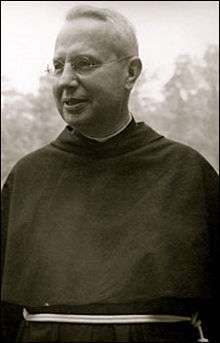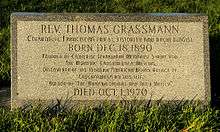Thomas Grassmann
Rev. Thomas Grassmann, OFM Conv, (December 18, 1890 – October 1, 1970) was a Conventual Franciscan friar and historian and archaeologist of Colonial New York, who discovered the site of the Mohawk American Village of Caughnawaga near Fonda, New York.

Biography
In 1938 Father Grassmann founded the Fonda Memorial of Catherine Tekakwitha near Fonda, New York. This was in the vicinity of the Mohawk settlement Caughnawaga, where Catholic convert Kateri Tekakwitha had lived part of her life (1656-1680) and been baptized.[1]
After preliminary exploration by members of the New York State Archaeological Association in the 1940s, Grassmann identified post molds of a stockade line, pinpointing the location, and led the thorough exploration of the site of Caughnawaga from 1950 to 1956. Excavation revealed a fortified, gated wooden double stockade, called a “castle,” and 12 long houses, covered with elm bark, inhabited by the Turtle Clan of the Mohawk from 1666-1693.[2][3]
Grassmann’s book The Mohawk Indians and their Valley: Being a Chronological Documentary Record to the End of 1693 (Schenectady, N.Y., Printed by Eric Hugo Photography and Print. Co., 1969) became a noted scholarly resource on the early history of the Mohawk Nation of Colonial New York.
The Caughnawaga Castle Site was declared a National Historical Place in 1973.[4]
The Fonda memorial, after the beatification of Kateri by the Catholic Church in 1980, is now the National Kateri Tekakwitha Shrine, whose museum houses the Mohawk Caughnawaga Collection assembled by Grassmann.[1]
Caughnawaga remains the only completely excavated Iroquois village in North America. Grassmann was honored by burial on the site he excavated.

References
- 1 2 The National Shrine of Blessed Kateri Tekakwitha, “History of the Shrine”
- ↑ “Catholics are fond of Fonda shrine dedicated to Blessed Kateri Tekakwitha” The (Albany, NY) Evangelist
- ↑ waymarking.com, “Mohawk & Iroquois Indian Burial Site”
- ↑ National Park Service, Survey of Historic Sites and Buildings